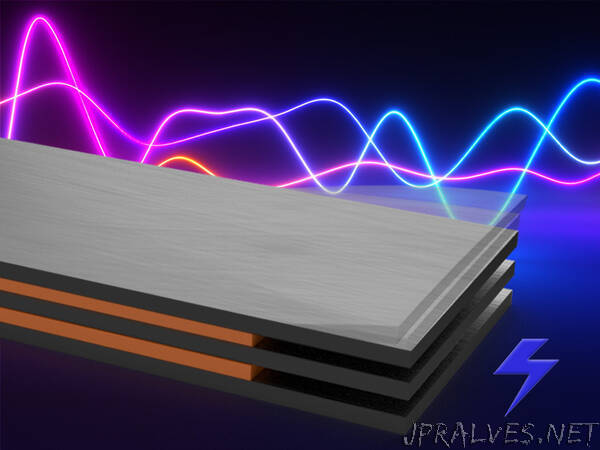
“Piezoelectric materials hold great promise as sensors and as energy harvesters but are normally much less effective at high temperatures, limiting their use in environments such as engines or space exploration. However, a new piezoelectric device developed by a team of researchers from Penn State and QorTek remains highly effective at elevated temperatures.
Clive Randall, director of Penn State’s Materials Research Institute (MRI), developed the material and device in partnership with researchers from QorTek, a State College, Pennsylvania-based company specializing in smart material devices and high-density power electronics.
“NASA’s need was how to power electronics in remote locations where batteries are difficult to access for changing,” Randall said. “They also wanted self-powering sensors that monitor systems such as engine stabilities and have these devices work during rocket launches and other high-temperature situations where current piezoelectrics fail due to the heat.”
Piezoelectric materials generate an electric charge when rapidly compressed by a mechanical force during vibrations or motion, such as from machinery or an engine. This can serve as a sensor to measure changes in pressure, temperature, strain or acceleration. Potentially, piezoelectrics could power a range of devices from personal electronics like wristband devices to bridge stability sensors.
The team integrated the material into a version of a piezoelectric energy harvester technology called a bimorph that enables the device to act either as a sensor, an energy harvester or an actuator. A bimorph has two piezoelectric layers shaped and assembled to maximize efficient energy harvesting. Sensors and energy harvesters, while bending the bimorph structure, generate an electrical signal for measurement or act as a power source.
Unfortunately, these functions work less-effectively in high-temperature environments. Current state-of-the-art piezoelectric energy harvesters are normally limited to a maximum effective operating temperature range of 176 degrees Fahrenheit (80 degrees Celsius) to 248 degrees Fahrenheit (120 degrees C).
“A fundamental problem with piezoelectric materials is their performance starts to drop pretty significantly at temperatures above 120 C, to the point where above 200 C (392 F) their performance is negligible,” Gareth Knowles, chief technical officer of QorTek, said. “Our research demonstrates a possible solution for that for NASA.”
The new piezoelectric material composition developed by the researchers showed a near-constant efficient performance at temperatures up to 482 F (250 C). In addition, while there was a gradual drop-off in performance above 482 F (250°C), the material remained effective as an energy harvester or sensor at temperatures to well-above 572 F the researchers reported in the Journal of Applied Physics.
“The compositions performing just as well at these high temperatures as they do at room temperature is a first, as no one has ever managed piezoelectric materials that effectively operate at such high temperatures,” Knowles said.
Another benefit of the material was an unexpectedly high level of electricity production. While at present, piezoelectric energy harvesters are not at the level of more efficient power producers such as solar cells, the new material’s performance was strong enough to open possibilities for other applications, according to Randall.
“The energy production part of this was very impressive, the material shows record performance efficiencies as a piezoelectric energy harvester,” Randall said. “This would potentially enable a continuous, battery-free power supply in dark or concealed environments such as inside an automotive system or even the human body.”
Both Randall and Knowles noted that the partnership between Penn State and QorTek, which goes back over 20 years, enabled development of the new, improved piezoelectric material by complementing each other’s resources.
“In general, a big benefit of a partnership like this is you can tap into the large knowledge reservoir in the field that MRI and Penn State has and that small companies like ours sometimes do not,” Knowles said. “Another benefit is often universities have physical resources such as equipment that again, you won’t ordinarily find inside a small company.”
Randall noted that since QorTek has many employees who are Penn State alumni, there is a familiarity with both the research subject and the people involved.
“One of my post-doctoral researchers and first author on the paper, Wei-Ting Chen, was hired by QorTek so there was a transfer of expertise in that case,” Randall said. “Also, the skillsets offered by QorTek such as mechanical engineering, device design and measurement expertise pushed development at a much faster rate than would be possible given the budget we were given. So the partnership enabled a really fruitful amplification of the project.”
Along with Randall and Chen, other authors on the paper include from Penn State, Xiao-Ming Chen, MRI research assistant, and from QorTek, Safakcan Tuncdemir, vice president of materials and devices; Ahmet Erkan Gurdal, materials group manager; and Josh Gambal, mechanical design engineer.
The National Aeronautics and Space Administration’s Small Business Technology Transfer Program and the National Science Foundation funded this research.”
